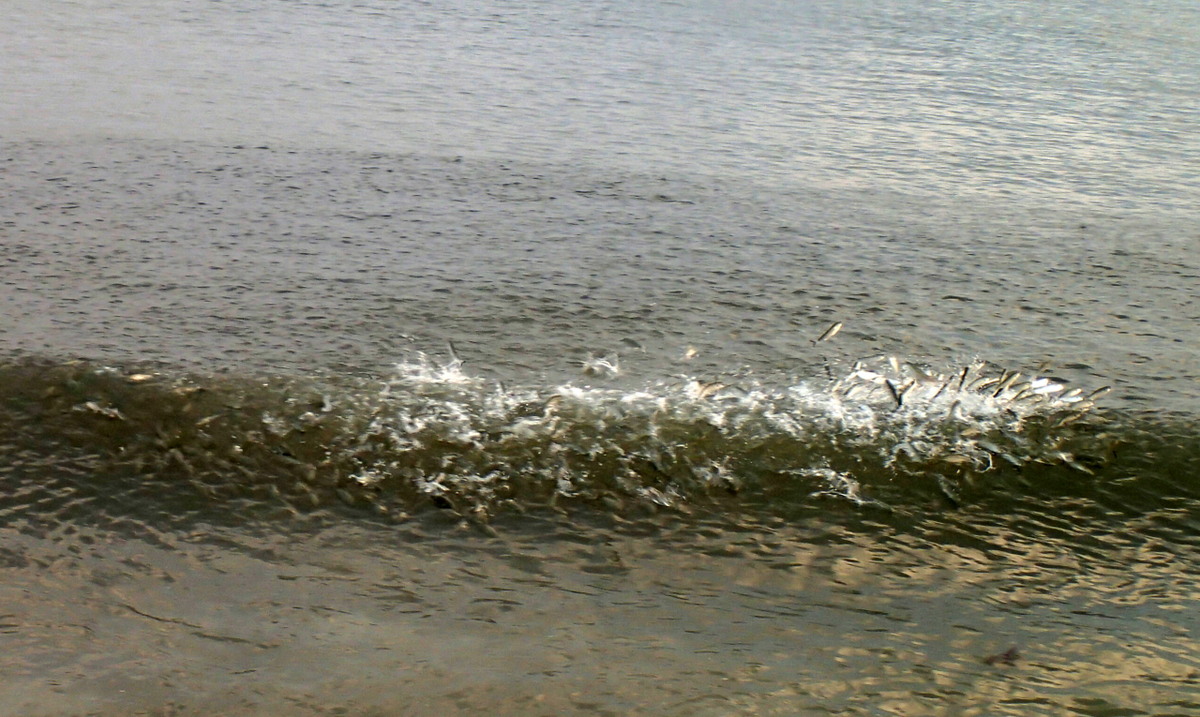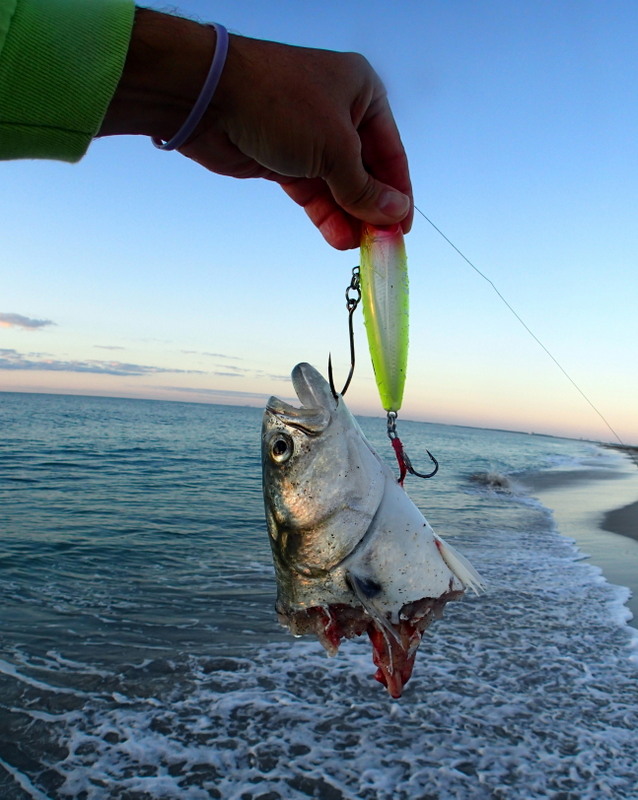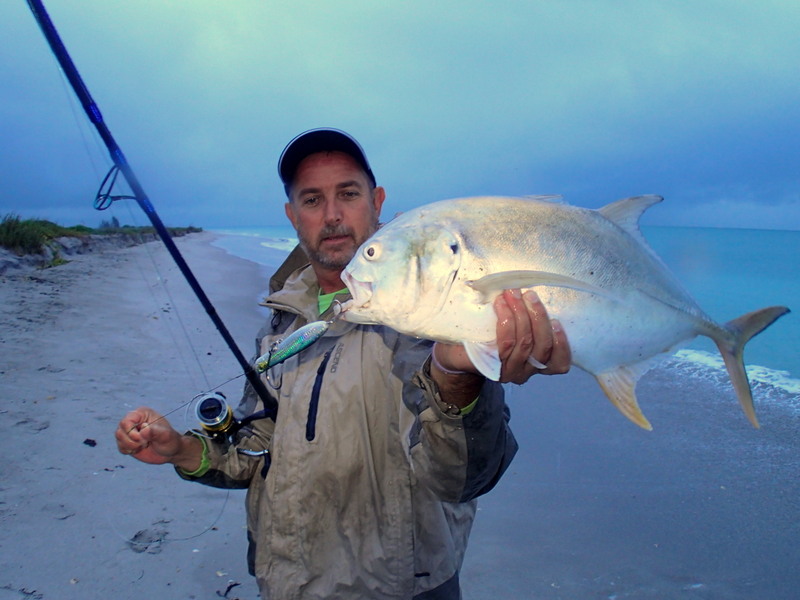By Paul MacInnis
Around the end of August I pack my surf fishing gear in my truck and it stays there until sometime in November. It’s all for the fall mullet run, the most fast paced fishing season of the year. If you’ve heard of the mullet run, want to try it out but aren’t sure where to start; here is my quick rundown of the who, what, where, when and how of the fall mullet run.
Who: This one’s easy, you, me and anyone else interested in lots of fish catching action for everything from one pound jack all the way up to triple digit tarpon and sharks.
What: The mullet run is a mass migration of mullet, from fingerlings to full sized adults that migrate down the east coast of Florida every fall. Every inshore fish in Florida that eats mullet can be caught during the mullet run. Incredible numbers of bluefish, jack crevale, ladyfish and Spanish mackerel harass almost every school of finger mullet passing our coast. Snook, redfish, seatrout and flounder prowl the inlets, jetties and the first trough along the beach. Giant tarpon will ravage the mullet schools, especially during the first half of the run, and sharks of all sizes shadow the bait pods and readily chase down topwater plugs or any bluefish, jack or other fish you happen to hook.
Where: Mullet pods will be moving north to south along all Space Coast beaches. Most of the surf mullet will be found from right against the shore out to a hundred yards or so. Jetties and inlets are good places to fish as they form natural choke points that seem to congregate the passing bait schools and predators. Some of the mullet come in through the inlets and will migrate down the intracoastal waterway. Regardless of whether you are fishing the beach, inlet or lagoon, the best place to cast your line is where the bait pods are the thickest.
If you are lucky, hundreds of mullet leaping out of the water, fleeing hungry predators, will tip you off to the locations of the bait schools. Diving birds can also help you find the fish. On sunny days, don a good pair of polarized sunglasses (I use Hobie Hydro Series Sunglasses) and the bait pods will show up as moving dark spots in the water, looking much like the shadow of a small passing cloud. In the surf, good polarized glasses will help you spot mullet in the faces of incoming waves, and if you have a trained eye, mullets schools reveal themselves by subtle ripples on the surface that are often referred to as nervous water.
When: The first schools of migrating mullet typically arrive along Brevard County around the end of August. The run is at its peak about mid-September until the end of October. Usually the last bait schools and accompanying predators leave our coast by mid to late November.
Mullet schools tend to come through in waves. Some days there is nary a mullet to be found while other times bait pods will darken the water as far as the eye can see. Obviously fishing is best when mullet schools are most numerous. That being said, I find there is almost always a good bite the first couple hours of daylight in the morning.
Another important consideration is the mullet run coincides with the peak of hurricane season. Tropical weather systems and cold fronts can produce rough seas and squally weather that make fishing impractical for days, sometimes weeks at a time. For this reason I like to fish the mullet run whenever I can because I never know when bad weather may keep me from fishing for an extended time. In my opinion, chores can wait for the bad weather days. Fish while the fishing is good.
How: Just about any bait or lure that resembles a mullet will get eaten during the mullet run. A live finger mullet is a no-brainer. Pin it to a 2/0 to 5/0 Daiichi circle hook tied to a couple feet of 50-60 pound mono or fluorocarbon leader and use a sinker just heavy of enough to keep it on the bottom. Dead finger mullet and mullet chunks work almost as well as a livie, and any mullet imitating lure will work. I tend to favor plugs and spoons most days over soft plastics as there are usually plenty of bluefish, mackerel and other sharp toothed predators to shred up your supply of soft baits.
My favorite lures are topwater plugs, especially in the morning. Inferior topwater plugs can get destroyed by some to the big, tough fish you can encounter during the mullet run so use lures designed specifically for heavy duty saltwater applications. One lure that has served me well over the years and is inexpensive is the Offshore Angler Pencil Popper in the smaller 5-1/4 inch, 1-1/4 ounce size. I find most plugs, including the Offshore Angler come with hooks that can be straightened by a big fish so I swap out the stock hooks with Daiichi 7x D98Q treble hooks in the 1/0 and 2/0 sizes or in-line single hooks like the VMC ILS 3/0 to 6/0.
A typical setup for mullet run fishing is a 4000 sized reel spooled with 20 pound test braid. If you want to target sharks and tarpon up your line to 30 to 50 pound test and choose a reel that can hold 300 yards or more. Standard seven foot rods work for inlet, jetty and inshore work and for fishing the first trough along the beach. For casting big plugs and spoons in the surf I like a nine foot surf rod like the Okuma Cedros CSX-S-902MH.
An entire book could be written on fishing the fall mullet run. Hopefully there is enough here to get you started. When the weather is nice I urge you to head out to the beach or inlet for what could be the most frenetic, exciting fishing of the year.





